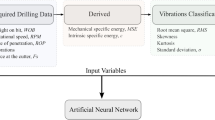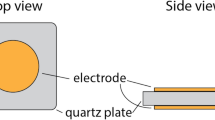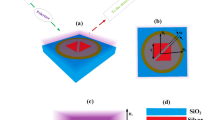Abstract
Photonic crystal fiber design based on surface plasmon resonance phenomenon (PCF-SPR) is optimized before it is fabricated for a particular application. An artificial intelligence algorithm is evaluated here to increase the ease of the simulation process for common users. COMSOL™ MultiPhysics is used. The algorithm suggests best among eight standard machine learning and one deep learning model to automatically select the desired mode, chosen visually by the experts otherwise. A total seven performance indices: namely, precision, recall, accuracy, F1-score, specificity, and Matthew correlation coefficient, are utilized to make the optimal decision. Robustness toward variations in sensor geometry design is also considered an optimal parameter. Several PCF-SPR-based photonic sensor designs are tested, and a large range optimal (based on phase matching) design is proposed. For this design algorithm has selected support vector machine (SVM) as the best option with an accuracy of 96%, F1-score is 95.83%, and MCC of 92.30%. The average sensitivity of the proposed sensor design with respect to change in refractive index (1.37–1.41) is 5500 nm/RIU. Resolution is 2.0498 \(\times {10}^{-5}\) \({\mathrm{RIU}}^{-1}\). The algorithm can be integrated into commercial software as an add-on or as a module in academic codes. The proposed novel step has saved approximately 75 min in the overall design process. The present work is equally applicable for mode selection of sensor other than PCF-SPR sensing geometries.











Similar content being viewed by others
Availability of Data and Materials
Data will be provided on request.
References
Li L, Huang T, Zhao X, Wu X, Cheng Z (2018) Highly sensitive SPR sensor based on hybrid coupling between plasmon and photonic mode. IEEE Photonics Technol Lett 30(15):1364–1367
Jabin M, Ahmed K, Rana M, Paul BK, Islam M, DV et al (2019) Surface plasmon resonance based titanium coated biosensor for cancer cell detection. IEEE Photonics J 1
Kaur V, Singh S (2019) Design of titanium nitride coated PCF-SPR sensor for liquid sensing applications. Opt Fiber Technol 48:159–164
Singh Y, Paswan MK, Raghuwanshi SK (2021) Sensitivity enhancement of SPR sensor with the black phosphorus and graphene with bi-layer of gold for chemical sensing. Plasmonics 1–10
Homola J (2008) Surface plasmon resonance sensors for detection of chemical and biological species. Chem Rev 108(2):462–493
Nooke A, Beck U, Hertwig A, Krause A, Krüger H, Lohse V et al (2010) On the application of gold based SPR sensors for the detection of hazardous gases. Sens Actuators B Chem 149(1):194–198
Li L, Liang Y, Guang J, Cui W, Zhang X, Masson JF et al (2017) Dual Kretschmann and Otto configuration fiber surface plasmon resonance biosensor. Opt Express 25(22):26950–26957
Rifat AA, Hasan MR, Ahmed R, Butt H (2017) Photonic crystal fiber-based plasmonic biosensor with external sensing approach. J Nanophotonics 12(1):12503
Liedberg B, Nylander C, Lunström I (1983) Surface plasmon resonance for gas detection and biosensing. Sensors and Actuators 4:299–304
Zhang S, Zhang P, Dong Z, Xu D, Wang D, Li J (2023) Highly efficient D-type photonic crystal fiber surface plasmon resonance sensor for same space–time temperature and refractive index detection. Plasmonics [Internet]. [cited 2023 Aug 6] 18(1):373–84. Available from: https://link.springer.com/article/10.1007/s11468-022-01774-w
Wang D, Zhang S, Li Y, Li J (2022) Highly efficient asymmetric dual refractive index D-type photonic crystal fiber surface plasmon resonance sensor. Plasmonics [Internet]. [cited 2023 Aug 6];17(5):2063–74. Available from: https://link.springer.com/article/10.1007/s11468-022-01694-9
Haque E, Hossain MdA, Ahmed F, Namihira Y (2018) Surface plasmon resonance sensor based on modified D-shaped photonic crystal fiber for wider range of refractive index detection. IEEE Sens J 1
Homola J (2003) Present and future of surface plasmon resonance biosensors. Anal Bioanal Chem 377(3):528–539
McPeak KM, Jayanti SV, Kress SJP, Meyer S, Iotti S, Rossinelli A et al (2015) Plasmonic films can easily be better: rules and recipes. ACS Photonics 2(3):326–333
Dash JN, Jha R (2014) Graphene-based birefringent photonic crystal fiber sensor using surface plasmon resonance. IEEE Photonics Technol Lett 26(11):1092–1095
Zynio SA, Samoylov AV, Surovtseva ER, Mirsky VM, Shirshov YM (2002) Bimetallic layers increase sensitivity of affinity sensors based on surface plasmon resonance. Sensors 2(2):62–70
El-Saeed AH, Khalil AE, Hameed MFO, Azab MY, Obayya SSA (2019) Highly sensitive SPR PCF biosensors based on Ag/TiN and Ag/ZrN configurations. Opt Quantum Electron 51(2):56
Farmer DB, Avouris P, Li Y, Heinz TF, Han SJ (2016) Ultrasensitive plasmonic detection of molecules with graphene. ACS Photonics 3(4):553–557
Kravets VG, Jalil R, Kim YJ, Ansell D, Aznakayeva DE, Thackray B et al (2014) Graphene-protected copper and silver plasmonics. Sci Rep 4(1):1–8
West PR, Ishii S, Naik GV, Emani NK, Shalaev VM, Boltasseva A (2010) Searching for better plasmonic materials. Laser Photon Rev 4(6):795–808
Hassani A, Skorobogatiy M (2006) Design of the microstructured optical fiber-based surface plasmon resonance sensors with enhanced microfluidics. Opt Express 14(24):11616–11621
Fan Z, Li S, Liu Q, An G, Chen H, Li J et al (2015) High sensitivity of refractive index sensor based on analyte-filled photonic crystal fiber with surface plasmon resonance. IEEE Photonics J 7(3):1–9
Shuai B, Xia L, Liu D (2012) Coexistence of positive and negative refractive index sensitivity in the liquid-core photonic crystal fiber based plasmonic sensor. Opt Express 20(23):25858–25866
Rifat AA, Mahdiraji GA, Chow DM, Shee YG, Ahmed R, Adikan FRM (2015) Photonic crystal fiber-based surface plasmon resonance sensor with selective analyte channels and graphene-silver deposited core. Sensors 15(5):11499–11510
Fu X, Lu Y, Huang X, Yao JQ (2011) Surface plasmon resonance sensor based on photonic crystal fiber filled with silver nanowires. Opt Appl 41(4):941–951
Lu Y, Yang X, Wang M, Yao J (2015) Surface plasmon resonance sensor based on hollow-core PCFs filled with silver nanowires. Electron Lett 51(21):1675–1677
Lu Y, Wang MT, Hao CJ, Zhao ZQ, Yao JQ (2014) Temperature sensing using photonic crystal fiber filled with silver nanowires and liquid. IEEE Photonics J 6(3):1–7
Islam MdS, Sultana J, Rifat Ahmmed A, Ahmed R, Dinovitser A, Ng BWH et al (2018) Dual-polarized highly sensitive plasmonic sensor in the visible to near-IR spectrum. Opt Express 26(23):30347–61
Wang F, Liu C, Sun Z, Sun T, Liu B, Chu PK (2018) A highly sensitive SPR sensors based on two parallel PCFs for low refractive index detection. IEEE Photonics J 10(4):1–10
Noman A AI, Haque E, Hossain M, Hai NH, Namihira Y, Ahmed F (2020) Sensitivity enhancement of modified D-shaped microchannel PCF-based surface plasmon resonance sensor. Sensors 20(21):6049
Biplob Hossain Md, Riazul Islam SM, Tasrif Hossain KM, Faisal Abdulrazak L, Nazmus Sakib Md, Amiri IS (2020) High sensitivity hollow core circular shaped PCF surface plasmonic biosensor employing silver coat: a numerical design and analysis with external sensing approach. Results Phys 16:102909
Fang H, Wei C, Wang D, Yuan L, Jiao S, Bao Z et al (2020) Research on photonic crystal fiber based on a surface plasmon resonance sensor with segmented silver-titanium dioxide film. Journal of the Optical Society of America B 37(3):736–744
Rifat AA, Ahmed R, Yetisen AK, Butt H, Sabouri A, Mahdiraji GA et al (2017) Photonic crystal fiber based plasmonic sensors. Sens Actuators B Chem 243:311–325
Tian M, Lu P, Chen L, Lv C, Liu D (2012) All-solid D-shaped photonic fiber sensor based on surface plasmon resonance. Opt Commun 285(6):1550–1554
Rifat AA, Mahdiraji GA, Sua YM, Shee YG, Ahmed R, Chow DM et al (2015) Surface plasmon resonance photonic crystal fiber biosensor: a practical sensing approach. IEEE Photonics Technol Lett 27(15):1628–1631
Yasli A, Akowuah EK, Haxha S, Ademgil H (2016) Photonic crystal fiber based surface plasmon sensor design and analyze with elliptical air holes. In: 2016 HONET-ICT 75–8
Lu J, Li Y, Han Y, Liu Y, Gao J (2018) D-shaped photonic crystal fiber plasmonic refractive index sensor based on gold grating. Appl Opt 57(19):5268–5272
Luan N, Wang R, Lv W, Yao J (2015) Surface plasmon resonance sensor based on D-shaped microstructured optical fiber with hollow core. Opt Express 23(7):8576–8582
Haque E, Hossain MdA, Ahmed F, Namihira Y (2018) Surface plasmon resonance sensor based on modified D-shaped photonic crystal fiber for wider range of refractive index detection. IEEE Sens J 1
Zelaci A, Yasli A, Kalyoncu C, Ademgil H (2021) Generative adversarial neural networks model of photonic crystal fiber based surface plasmon resonance sensor. J Lightwave Technol 39(5):1515–1522
Chugh S, Gulistan A, Ghosh S, Rahman BMA (2019) Machine learning approach for computing optical properties of a photonic crystal fiber. Opt Express 27(25):36414–36425
da Ferreira A S, Malheiros-Silveira GN, Hernández-Figueroa HE (2018) Computing optical properties of photonic crystals by using multilayer perceptron and extreme learning machine. J Light Technol 36(18):4066–73
Kiarashinejad Y, Zandehshahvar M, Abdollahramezani S, Hemmatyar O, Pourabolghasem R, Adibi A (2020) Knowledge discovery in nanophotonics using geometric deep learning. Advanced Intelligent Systems 2(2):1900132
Asano T, Noda S (2018) Optimization of photonic crystal nanocavities based on deep learning. Opt Express 26(25):32704–32717
McAtee PD, Bukkapatnam STS, Lakhtakia A (2019) Artificial neural network to estimate the refractive index of a liquid infiltrating a chiral sculptured thin film. J Nanophotonics 13(4):46006
YouTube [Internet]. [cited 2021 Jul 9]. Available from: https://www.youtube.com/watch?v=tidL5PJ73CQ
Roli F, Fumera G (2001) Support vector machines for remote sensing image classification. In: Image and signal processing for remote sensing VI. International Society for Optics and Photonics 160–6
Cortes C, Vapnik V (1995) Support-vector networks. Mach Learn 20(3):273–297
Wang H, Zheng B, Yoon SW, Ko HS (2018) A support vector machine-based ensemble algorithm for breast cancer diagnosis. Eur J Oper Res 267(2):687–699
Quinlan JR (1996) Learning decision tree classifiers. ACM Computing Surveys (CSUR) 28(1):71–72
Rodriguez-Galiano VF, Ghimire B, Rogan J, Chica-Olmo M, Rigol-Sanchez JP (2012) An assessment of the effectiveness of a random forest classifier for land-cover classification. ISPRS J Photogramm Remote Sens 67:93–104
Breiman L (1996) Bagging predictors. Mach Learn 24(2):123–140
Freund Y, Schapire RE (1997) A decision-theoretic generalization of on-line learning and an application to boosting. J Comput Syst Sci 55(1):119–139
Breiman L (2001) Random forests. Mach Learn 45(1):5–32
Schapire RE (1990) The strength of weak learnability. Mach Learn 5(2):197–227
Friedman JH (2001) Greedy function approximation: a gradient boosting machine. Ann Stat 1189–232
Drucker H, Schapire R, Simard P (1993) Boosting performance in neural networks. In: Advances in pattern recognition systems using neural network technologies. World Sci 61–75
Wolpert DH (1992) Stacked generalization. Neural Netw 5(2):241–259
Flach PA, Lachiche N (2004) Naive Bayesian classification of structured data. Mach Learn 57(3):233–269
Domingos P, Pazzani M (1997) On the optimality of the simple Bayesian classifier under zero-one loss. Mach Learn 29(2):103–130
Lei X, Pan H, Huang X (2019) A dilated CNN model for image classification. IEEE Access 7:124087–124095
Sharif V, Pakarzadeh H (2023) High-performance surface plasmon resonance fiber sensor based on cylindrical vector modes. Scientific Reports 2023 13:1 [Internet]. [cited 2023 Aug 6] 13(1):1–9. Available from: https://www.nature.com/articles/s41598-023-31524-9
Ramola A, Marwaha A, Singh S (2021) Design and investigation of a dedicated PCF SPR biosensor for CANCER exposure employing external sensing. Appl Phys A Mater Sci Process [Internet]. [cited 2023 Aug 6] 127(9):1–20. Available from: https://link.springer.com/article/10.1007/s00339-021-04785-2
Rahman MM, Rana MM, Anower MS, Rahman MS, Paul AK (2020) Design and analysis of photonic crystal fiber-based plasmonic microbiosensor: an external sensing scheme. SN Appl Sci [Internet]. [cited 2023 Aug 6] 2(7):1–11. Available from: https://link.springer.com/article/10.1007/s42452-020-2998-3
Khalek MdA, Chakma S, Paul BK, Ahmed K (2018) Dataset of surface plasmon resonance based on photonic crystal fiber for chemical sensing applications. Data Brief 19:76–81
Yap BW, Abd Rani K, Abd Rahman HA, Fong S, Khairudin Z, Abdullah NN (2014) An application of oversampling, undersampling, bagging and boosting in handling imbalanced datasets. Proceedings of the first international conference on advanced data and information engineering (DaEng-2013). Springer p. 13–22
Run COMSOL Multiphysics® Simulations with MATLAB® [Internet]. [cited 2023 Aug 4]. Available from: https://www.comsol.com/livelink-for-matlab#cta-section
How to Integrate External Data Files with Your COMSOL® App | COMSOL Blog [Internet]. [cited 2023 Aug 4]. Available from: https://www.comsol.com/blogs/how-to-integrate-external-data-files-with-your-comsol-app/
Sakib MdN, Hossain MbB, Al-tabatabaie KF, Mehedi IM, Hasan MdT, Hossain MdA et al (2019) High performance dual core D-shape PCF-SPR sensor modeling employing gold coat. Results Phys 15:102788
Biplob Hossain Md, Riazul Islam SM, Tasrif Hossain KM, Faisal Abdulrazak L, Nazmus Sakib Md, Amiri IS (2020) High sensitivity hollow core circular shaped PCF surface plasmonic biosensor employing silver coat: a numerical design and analysis with external sensing approach. Results Phys 16:102909
Hu DJJ, Ho HP (2017) Recent advances in plasmonic photonic crystal fibers: design, fabrication and applications. Adv Opt Photonics 9(2):257–314
Weng S, Pei L, Wang J, Ning T, Li J (2017) High sensitivity D-shaped hole fiber temperature sensor based on surface plasmon resonance with liquid filling. Photonics Res 5(2):103–107
Tan Z, Hao X, Shao Y, Chen Y, Li X, Fan P (2014) Phase modulation and structural effects in a D-shaped all-solid photonic crystal fiber surface plasmon resonance sensor. Opt Express 22(12):15049–15063
Chopra H, Kaler RS, Painam B (2016) Photonic crystal waveguide-based biosensor for detection of diseases. J Nanophotonics 10(3):36011
Hutson M (2018) Artificial intelligence faces reproducibility crisis. Science (1979) [Internet]. 359(6377):725–6. Available from: https://science.sciencemag.org/content/359/6377/725
Raff E (2019) A Step Toward quantifying independently reproducible machine learning research. [cited 2021 Jul 8]; Available from: http://arxiv.org/abs/1909.06674
Acknowledgements
We would like to acknowledge Prof. Sachin K. Srivastava for inspiring Ms. Prasunika to initiate work in this direction via his coursework.
Funding
This work is partially supported by GRANT Code I.M.P./2018/001045 by IMPRINT-II by S.E.R.B., Government of India.
Author information
Authors and Affiliations
Contributions
Mayank Goswami: conceptualization, methodology, investigation, writing, visualization, supervision, and funding acquisition. Prasunika Khare: software and methodology, Snehlata Shakya: software verification, and re-investigation.
Corresponding author
Ethics declarations
Competing Interests
The authors declare no competing interests.
Additional information
Publisher's Note
Springer Nature remains neutral with regard to jurisdictional claims in published maps and institutional affiliations.
Supplementary Information
Below is the link to the electronic supplementary material.
Rights and permissions
Springer Nature or its licensor (e.g. a society or other partner) holds exclusive rights to this article under a publishing agreement with the author(s) or other rightsholder(s); author self-archiving of the accepted manuscript version of this article is solely governed by the terms of such publishing agreement and applicable law.
About this article
Cite this article
Goswami, M., Khare, P. & Shakya, S. AI Algorithm for Mode Classification of PCF-SPR Sensor Design. Plasmonics 19, 363–377 (2024). https://doi.org/10.1007/s11468-023-01997-5
Received:
Accepted:
Published:
Issue Date:
DOI: https://doi.org/10.1007/s11468-023-01997-5




